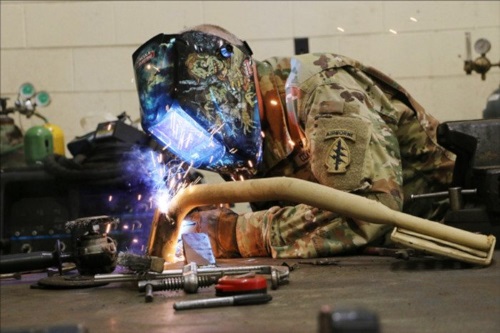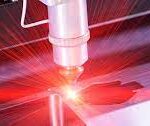This article is all about the tools that welders want to have in their shop. They make welding easier, and in many cases, they make the welding process — from start to cleanup — more enjoyable. If you’re new to welding and you have a birthday coming up, you’re going to want to start dropping hints about these tools to your family. As with every single tool or piece of equipment I mention in this article, you need to read all the information (instructions and safety details) included with the tool before you use it. Tools can be extremely dangerous if you don’t use them correctly. You’re going to be spending a lot of time with your tools if you really get into welding, so treat them well. Be sure you buy tools that are the right size because tools that are too small or too large for you can be uncomfortable or dangerous. Keep your tools clean, and wipe them down with a rag after each use. If your tool has a blade, keep it sharp. When you’re carrying or transporting tools, do so in a way that doesn’t result in injury for you or anyone nearby. And finally, if your tools break down, get them repaired properly or replace them. Don’t just slap on some duct tape and hope for the best.
4 1 /2-Inch Grinder
Grinders are really dynamic tools, and they’re a cinch to use after you’ve had some practice. I love having a 4 /2-inch grinder in my welding shop. You rarely get all the way through a welding project without having to thoroughly clean or otherwise alter the surface of a metal, and a grinder is an excellent way to get that done in a fast, efficient way. You may be amazed at how often you need to remove rust, grind a groove into something, or smooth down a rough surface.
Part of the magic of a grinder is the variety of attachments you can use with it. Need to smooth something out? Use your flap sanding disc. Want to clean up a piece of cast iron before you weld it? Try your wire brush attachment. Need to grind down some aluminum or another nonferrous (iron-free) metal? Attach your nonferrous grinding disc and get started. You can buy a good new grinder for about $100. Like all power tools, grinders must be properly grounded to prevent electrical shock. Don’t use your grinder with excessive force, and if it feels or smells hot, you’re working it too hard (so back off). If you use an extension cord, make sure the cord is rated to handle the electrical load necessary to run the tool without damaging the tool or the cord.
Hacksaw
A hacksaw is a small, versatile, handheld saw that allows you to use all kinds of different blades designed to cut various materials (including a range of metals). Hacksaws are relatively inexpensive, and you’ll probably enjoy having one around. You can pick up a hacksaw for about $10 at your local hardware store or home improvement warehouse, and replacement blades are usually less than $5 for a pack of two or three. When you use a hacksaw, make sure the teeth point forward so that you’re cutting on the stroke away from yourself. This setup helps you prevent inadvertent injury. Plus, starting the cut going away from your body is easier.
Air Compressor
Many of the welding processes, particularly stick welding , can create a mess and leave your projects (and work area) covered with particles. If you have an aircompressor with a blowgun attachment, you can use pressurized air to blow that stuff off on the floor so that you can easily broom it up later. That’s a lot quicker than having to wipe down or brush off all those surfaces. (Of course, if you have pneumatic tools, you need an air compressor anyway.) You should be able to pick up a quality aircompressor for about $180, and the ones available at your local hardware store are good and strong enough for most new welders. Air compressors are also very useful to have around if you think you may need to put air in the tires of vehicles, carts, or anything else along those lines.
3/8-Inch Electric Drill
The 3/8-inch electric drill (shown in Figure 19-1) is one of the most common and most popular drills available, and for good reason; you can use this kind of drill for all kinds of things in your home and shop. It’s great for drilling small holes in your welding jobs where necessary, and as you begin to take on a wider and wider range of projects, that need pops up more and more often. There are more than a dozen manufacturers of good-quality 3/8-inch electric drills, so read a few online reviews and ask your welding friends which brands they like before making your purchase. You can find cordless or corded options; I’m partial to the corded models, but if portability is tops on your priority list, a cordless model may be best for you. You can find these drills in a range of prices, from $30 all the way up to about $100.

Wrench
When you’re assembling or disassembling the parts of a welding project, a good wrench set can certainly come in handy. They’re also great for adjusting your tools and other equipment. You can always just stick with an adjustable wrench, which is a very versatile tool, but if you really want a perfect fit, sometimes the adjustable option just doesn’t cut it. I recommend getting a combination wrench set, which includes box- and open-end wrenches. Box-end wrenches have a closed loop on the end that you slide down over a bolt before applying force to the wrench. An open-end wrench,on the other hand, has more of an open jaw that you can use to slide onto the head of a bolt from the side. Combination wrench sets have a box end on one end and an open end on the other. Both ends can be helpful, so if you’re been particularly good this year, when Christmas rolls around you should ask for a set of combination wrenches. (You can see a set of combination wrenches in Figure 19-2.) You (or Santa) can expect to spend about $25 on a set of good wrenches.

Steel Sawhorses
A welding table is a necessity for any welding shop, and that’s the truth. You simply have to have a welding table if you want to get serious about welding. However, in addition to a table, you may also want to get a set of sturdy steel sawhorses like the ones in Figure 19-3. They can provide another means for getting your work up off the floor, making your work on certain objects or projects much easier. And believe me, if you’re comfortable when you’re welding, you produce much better work (and enjoy doing it)! If necessary, you can also use steel sawhorses as a base for a portable welding table, but don’t plan on using them day in and day out for that purpose because it’s just not as efficient or as safe. You can get a set of steel sawhorses for as little as $30 at a hardware store or home improvement superstore. I don’t recommend using wooden sawhorses for welding purposes. They’re just not nearly as strong or durable as their steel counterparts.

Cutoff Saw
If you haven’t worked with a lot of metals in the past, you may not be familiar with cutoff saws, which are a little different from the saws you use to cut other materials such as wood. Instead of using a blade, cutoff saws use an abrasive wheel to make cuts. The wheels are like grinding wheels, but they’re quite thin; they spin at a very high speed and operate on a dry basis. (Some saws for other types of trades require a wet working area.) You can see a good example of a cutoff saw in Figure 19-4 I like cutoff saws because the cuts they produce require very little if any cleanup. They’re steady and smooth, too, and now that I’m used to having one around, I don’t think I would enjoy not having one in my shop. You can pick up a good cutoff saw for around $90. Before using a cutoff saw, make sure the piece to be cut is clamped very securely into the machine so that it doesn’t go flying, and be sure you apply force smoothly at a steady rate while you’re cutting. If you apply too much pressure, the cutting blade heats up and can bind to the piece you’re cutting.

Bench Grinder
A bench grinder is a great piece of equipment for general grinding tasks and for sharpening the tools in your shop. Bench grinders are usually about the size of a microwave, and you can attach them to the top of a workbench (not to the top of your welding table — that takes up too much space). If you haven’t seen a bench grinder before, take a look at Figure 19-5. You can buy one for about $50. Bench grinders are fitted with replaceable abrasive wheels on both ends. The abrasive wheels are made of a stone material and come in different types for grinding different kinds of metal. Never grind a nonferrous metal with a ferrous abrasive wheel because it can plug up the metal and explode. Ferrous abrasive wheels are used for grinding cast iron, steel, and stainless steel, and nonferrous abrasive wheels are for aluminum, copper, and brass. Use a tool rest when you’re sharpening tools with your bench grinder. Tool rests give you a good place to stabilize the tool and hold it steady while grinding. Keep the tool rest within 1/16 inch of the abrasive wheel. If for some reason you can’t hold the tool you’re grinding with both hands, use pliers or vise grips to keep it steady. I know it may sound counterintuitive, but don’t wear gloves when you’re using a bench grinder. If the stone happens to catch your glove, it will pull your hand into the grinder and cause serious injury.

Bottle Jack
This option is definitely the kind of tool where the “better to have it and not need it than to need it and not have it” rule applies. If you think you may need to lift heavy materials or pieces in tight spaces, you’ll be glad you invested in a $35 bottle jack. A bottle jack (shown in Figure 19-6) is a small hydraulic jack that can move a lot of weight in a vertical direction with little effort from the user. You can find bottle jacks in different sizes; the bigger ones are generally capable of lifting more weight. The difference in price isn’t that much from one jack to another, so I recommend getting a big one.

Toolbox
You really can’t beat a durable, trusty toolbox. These heavy-duty boxes store your tools in an organized, safe way. If you don’t have a toolbox already, I’d put this item near the top of your wish list. (And if you already have one currently filled with tools for other crafts, such as carpentry or plumbing, consider getting a toolbox exclusively for welding-specific tools). Toolboxes come in a dizzying array of sizes, from the kind you can fit into the glove box of a car to the kind mounted on wheels that can hold a ton (literally) of tools. Because of the range in sizes, toolboxes can cost anywhere from $10 to $5,000. You can see a medium-sized, basic toolbox in Figure 19-7. Most of the bigger boxes have locks on them, or at least some kind of sturdy latch you can use a padlock or combination lock on. I’m a big supporter of locking toolboxes, and because it’s not an expensive feature, I recommend you strongly consider it when you go to buy a toolbox.



